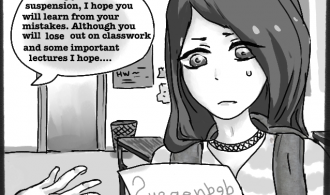It Is Time to Suspend Detrimental Suspensions
XIAOYE WANG
Staff Writer
Because school suspensions are easy to administer, oversee and track, they are a disciplinary action that many schools turn to when students misbehave. As such, suspension rates in the United States are high. However, students should not be suspended from school because it does little to no good in fixing their behavior and only sets them back in school.
Of the 49 million students enrolled in public schools, 3.5 million students were suspended in-school in 2011-2012, while 3.45 million students were suspended out of school. This is a cumulative loss of almost 18 million school days and is a negative consequence of the zero-tolerance policies around schools where students are given no second chances.
In addition, suspensions do not help because students are alienated from the student body. Some students see it as a vacation from their schoolwork while others are sent back to disjointed homes where their problems may have arose in the first place. They are not taught proper behaviors during their absence from school and often stay at home unsupervised because of their parents’ work. The days they miss from school also set them back from the rest of the peers. According to the Journal of School Violence, suspensions actually tend to intensify problems in behavior and lead to struggles in academics.
Instead of suspending youths, schools should focus more on restorative justice. Restorative justice is essentially a system that focuses on rehabilitating students by reconciling them with the student body and community.
Restorative justice seems childish at first glance. Students gather together with teachers and other students in meditation centers. Administrators volunteer as peer mediators and help struggling students share out and discuss what is disrupting them from their studies and life. Essentially, it is a share out. While it is hard for administrators to get enough tools and time to help these students, restorative circles can help students in a long run by reforming them and is clearly effective. Positive reinforcement goes a long way in the improvement of a teenager’s psyche. In a school in Coney Island, for example, the implementation of restorative justice has lowered suspension by more than 40 percent in the schools. Credit accumulation in students, attendance rates, and graduation rates have also all gone up as well.
Overall, student suspensions should be repealed because of the suspension’s inability to help and change the student. The school should focus more on helping students by understanding the reasons for their behavior and trying to help them work them out instead of doing nothing about the problem.
